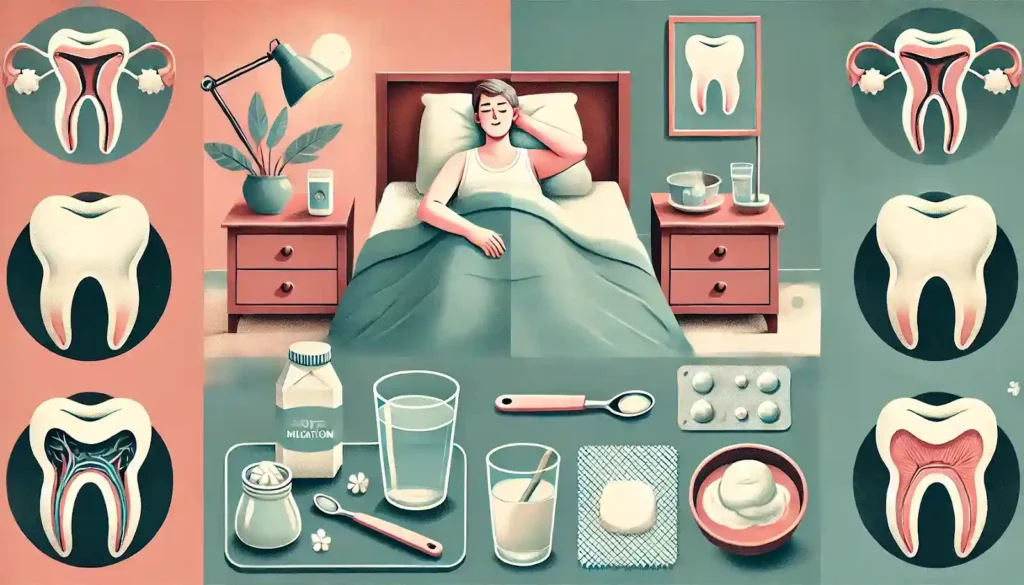First Night After Tooth Extraction: Essential Tips for Rest, Healing, and Comfort
The first night after tooth extraction is an important phase in your recovery process. Managing discomfort, following aftercare instructions, and resting properly can make a significant difference in your healing journey. This guide will walk you through the key challenges, pain relief tips, sleep strategies, and dietary recommendations to ensure a smooth recovery. With the right care, you can minimize complications and wake up the next day feeling much better.
Common Challenges During the First Night After Tooth Extraction
During the first night after tooth extraction, it’s normal to experience several challenges. Preparing for these difficulties can help you manage them effectively:
- Pain and Discomfort: Mild to moderate pain is typical as the anesthesia wears off.
- Bleeding: Some oozing is common and can be controlled by biting down on gauze pads.
- Swelling: Swelling at the extraction site usually peaks after 24-48 hours.
- Sleep Issues: Pain and discomfort can make it difficult to get restful sleep.
Understanding what to expect allows you to take proactive steps to stay comfortable through the night and avoid potential setbacks like dry socket.
Also read about: Tooth Crown Before and After: Stunning Transformations for Front and Molar Teeth
How to Sleep Comfortably the First Night After Tooth Extraction
Proper sleep plays a vital role in the healing process. Here are some tips to ensure a good night’s rest:
- Use Extra Pillows: Elevate your head to reduce swelling and promote blood flow.
- Avoid Sleeping on the Affected Side: This prevents pressure on the extraction site and minimizes discomfort.
- Prepare for Bed Early: Take pain medication about 30 minutes before bedtime to prevent waking up in pain.
- Practice Sleep Hygiene: Create a calm environment by keeping your room cool, dark, and quiet.
These adjustments help you avoid disturbances and improve your chances of getting a full night’s rest, essential for faster recovery.
Pain and Bleeding Management
Pain and bleeding are common during the first night after tooth extraction, but they can be managed effectively with the right approach:
- Pain Relief: Follow your dentist’s instructions and stick to prescribed medications. Over-the-counter options like ibuprofen help with both pain and inflammation.
- Gauze for Bleeding: Gently bite down on gauze pads for 30-40 minutes to control bleeding. If bleeding persists, replace the gauze and continue applying pressure.
- Cold Compress: Apply an ice pack on the cheek near the extraction site for 10 minutes at a time to reduce swelling and discomfort.
If pain becomes severe or bleeding continues for several hours despite using gauze, contact your dentist immediately. Addressing issues early can prevent complications and ensure a smooth recovery.
What to Eat the First Night After Tooth Extraction

Diet plays a crucial role in your recovery. Eating the right foods can soothe the extraction site and provide your body with essential nutrients:
Recommended Foods:
- Smooth yogurt
- Applesauce
- Mashed potatoes
- Pudding
- Ice cream
These foods are soft and cold, helping to reduce irritation and soothe the area.
Foods to Avoid:
- Hot or spicy foods
- Crunchy or hard foods (like chips)
- Sticky foods (like caramel)
- Foods requiring suction (like drinking through a straw)
Avoid using straws, as the suction can dislodge the blood clot, leading to dry socket. Gradually reintroduce solid foods over the next few days as your comfort improves.
Post-Extraction Care Tips for a Smooth Recovery
Proper aftercare during the first night after tooth extraction sets the tone for faster healing:
- Rinse Gently: After 24 hours, rinse your mouth with warm salt water to keep the area clean.
- Limit Physical Activity: Rest as much as possible to avoid unnecessary bleeding or swelling.
- Avoid Tobacco and Alcohol: These substances slow healing and increase the risk of complications.
- Monitor for Infections: Watch for signs like severe swelling, fever, or intense pain, which could indicate an infection.
By following these care instructions, you can prevent complications and encourage the formation of a healthy blood clot, essential for healing.
Table: Summary of Essential Care Tips
| Challenge | Care Tips |
| Pain | Take medication 30 minutes before bedtime |
| Bleeding | Use gauze to apply pressure; replace every 30 minutes |
| Swelling | Apply ice packs in 10-minute intervals |
| Sleep Discomfort | Use extra pillows to elevate your head |
| Diet Restrictions | Stick to soft, cold foods; avoid straws |
FAQs About the First Night After Tooth Extraction
- Is it normal to experience bleeding the first night?
Yes, light bleeding is typical. Use gauze to apply pressure, and avoid spitting or rinsing for 24 hours to protect the blood clot. - How can I tell if I have a dry socket?
A dry socket may present with severe pain, bad breath, and visible bone at the extraction site. If these symptoms occur, contact your dentist immediately. - Can I brush my teeth on the first night?
Avoid brushing the extraction site for 72 hours. Focus on brushing and flossing the other teeth carefully during this period. - When can I resume eating normally?
Soft foods are recommended for the first 24-48 hours. You can gradually reintroduce solid foods as your comfort level improves. - Is it safe to smoke after a tooth extraction?
No, smoking should be avoided for at least 48 hours to prevent dry socket and ensure proper healing.
Conclusion
The first night after tooth extraction is crucial for your recovery. By following pain management strategies, eating the right foods, and practicing proper sleep hygiene, you can minimize discomfort and encourage healing. Stick to your dentist’s aftercare instructions and make necessary adjustments to your routine to ensure a smooth recovery. If you experience severe pain or prolonged bleeding, don’t hesitate to reach out to your dentist. With a little care and attention, you’ll be well on your way to full recovery in no time.
Related Posts:
Before and After Partial Dentures: Transform Your Smile with Confidence
Tooth Is Loose but Still Attached in Adults: Causes, Treatment Options, and Prevention
Why Experts Now Say Not to Remove Your Wisdom Teeth
How Long Does a Crown Take? Traditional vs. Same-Day Crowns Explained
NY Monthly is a digital publication focused on exploring the pulse of New York City. Covering everything from travel, lifestyle, food, arts, business, and culture, NY Monthly brings the best stories to life. Our mission is to inform, inspire, and connect readers with the latest trends and hidden gems throughout the city and beyond.






